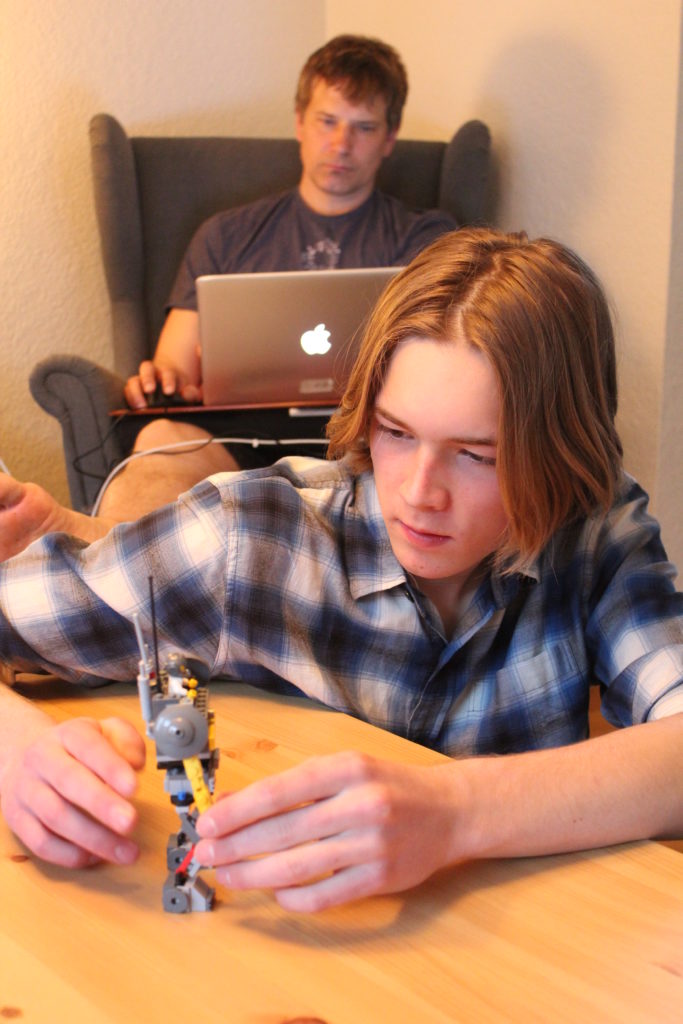
I wrote this piece in August 2018.
For the past two weeks, my social media has been dominated by American back-to-school pictures.
Last week it was kids with backpacks standing poised to step off the front porch into the conventional school world, and this week it has been by my homeschooling friends posting their images of life outside of school — kids playing in the backyard, kids reading in their pajamas and socks, kids snuggling on the couch with their mom, kids at a museum, kids at the beach.
And while my Swedish friends don’t seem as likely to post pictures of their children embarking on a new school year, I am fully aware that the season has dramatically changed: vacation is over, school is back in session. The schools are full and the houses are empty.
Except for us.
River is not going back to school. Earlier this month he went to the international school he attended last year, turned in his school-owned MacBook and unenrolled himself from school. In America, we might call him a high school dropout, and it is basically the same concept here in Sweden.
In Sweden, while it is legal for children over 16 to “drop out,” such a decision makes River instantly ineligible for the generous monthly stipend the Swedish government pays all students under 20. It also likely prevents him from attending the famously free Swedish universities and trade schools, as entrance to these institutions are only available for those who have passed through the conventional system. As far as I know, there is no legitimate path for independently learning students to validate their education and enter into the publicly-funded university system.
Sweden is one of the few remaining countries with draconian anti-homeschooling policies. Homeschooling is legal in neighboring Nordic countries: Norway, Denmark, and Finland, but in Sweden children under 16 are legally required to attend state-sanctioned schools. According to the international homeschooling rights advocacy group, Homes School Legal Defense, noncompliant families in Sweden have suffered fines, litigation, and in some cases, children have been removed from their homes and parental rights terminated. Some Swedish families have allegedly left Sweden to live in Swedish-speaking areas of neighboring Finland, rather than comply.
As one of my Swedish friends said, “Of course I have heard of homeschooling, but I have never met anyone who does it.”
It’s a radical step off of the conventional, accepted path, in a country that deeply respects convention; and I am well aware that River may be the only homeschooler in Sweden.
But River is 16 and legally eligible to “opt out,” of school, so thankfully we are not concerned about the legal ramifications for our family.
And, as this was primarily River’s request and decision, I am convinced that he is motivated and ready to work towards his goals, and I have no doubt that he will be successful.
But why homeschool in a country where we have no homeschooling community and little social support?
Kip and I decided to support River’s decision to return to homeschooling because we thought it was the best decision for him and for our family. I love Sweden and I respect the reality that society and culture are different here than in the US, but in the end, we had to do what works for us.
Here are a few of the many reasons homeschooling works for us here in Sweden.
Time for Creativity
 We were appalled at the amount of wasted time River described in his school experience. Modeled after the parents’ expected workday, the school day is long, often lasting from 8:15 until almost 5 p.m. During the winter River walked to school in the dark and came home in the dark. After school and homework, there was little time or energy left for him to engage in creative, life-giving activities he had always enjoyed like making stop-motion animation videos, playing guitar and skateboarding.
We were appalled at the amount of wasted time River described in his school experience. Modeled after the parents’ expected workday, the school day is long, often lasting from 8:15 until almost 5 p.m. During the winter River walked to school in the dark and came home in the dark. After school and homework, there was little time or energy left for him to engage in creative, life-giving activities he had always enjoyed like making stop-motion animation videos, playing guitar and skateboarding.
Educational Content
River attended a private International Baccalaureate school here in Sweden, and we had hoped when he enrolled that it would be an appropriately rigorous education. And while he enjoyed classes that he had never had before, like jazz class and design class, overall, we thought that most classes were less rigorous than the homeschooling options we had in Los Angeles. His English class, for instance, read and discussed only one book for the whole year. They also discussed the international epidemic of fake news, wrote one opinion piece and analyzed poetry, but it was a pale substitute for what our daughter had the year she was 15. During her sophomore year of high school, she studied and performed multiple Shakespearean plays, read 25 nonfiction and fiction books, wrote about 10 papers, wrote and delivered multiple speeches and made group presentations with her weekly “class” of homeschooling students.
Furthermore, going to school revealed areas that River needed to improve, but as is the nature of traditional school, there was little time to stop and catch up. With River being home during school hours, we are beginning to address the areas where he needs individual tutoring to get “back on track.”
Mentoring
When River was attending the IB school he had “mentors,” assigned, adults who were supposed to be involved in his academic life and help guide him in personal development as well. I initially liked the idea, but the reality was that these arbitrarily assigned mentors never developed much of a real relationship with River and subsequently never had much of an impact on his school experience or personal growth.

However, when we decided to homeschool here in Sweden, one of the first things we did was enlist the assistance of real mentors. I asked my dad, who is a medical doctor in the US, to oversee River’s biology program. River is working through an excellent biology textbook and will be fully participating in biology labs here, but by including my dad, River will have a weekly mentor meeting to talk to another adult who will be interested in his learning progress.
River also reached out to one of his favorite educational mentors in Los Angeles, Shawn Crane, a veteran homeschooling mother who has created her own homeschooling support organization that hosts excellent, rigorous, scholar-level classes for homeschooling teenagers. River will be following along the reading and writing assignments for one of her classes, participating in weekly class discussions by way of an Internet-based video conferencing call.
Social Life
When River started school last fall we had hoped it would be a good place for him to make local friend and connect with other teenagers living in Sweden. But for the most part, it really did not work out that way.
We found that after spending hours at school, the last thing River wanted to do was spend more time with his classmates. It was not until late spring that any of River’s friends from school came over, and even then, it was really just one friend that River wanted to get to know on a deeper level.
River found that his greatest source of friendship in Sweden was not at his English-speaking school, where he shared little common interest with other students, but at a Swedish youth group, a church just a few blocks from our apartment. Despite the fact that the youth group meetings were all in Swedish, River found that through translation and the kind hospitality of the youth group leaders, he could relate more deeply with the Swedish kids there. Since then he has developed strong friendships in this church and also at an international, English-speaking church we attend on Sundays. As a bonus, his natural connection with local teens has made him the most motivated person in our family to learn Swedish. He currently dominates the rest of us in Duolingo.
Do I worry that River will be lonely, come the middle of winter when the days are short and cold? Yes. I do. But as he so acutely responded when I suggested that, “I would rather be lonely at home than lonely at school.” Winter is winter in Sweden.
Freedom to Travel

Last spring River skipped the school trip to go on an epic motocross ride across the Italian Alps.
One of our main motivations for living in Europe was the opportunity to travel extensively. Already this summer we have seen Italy, Norway, Germany, Austria, Slovenia and Hungry. Last year Kip and I made it to Spain and Madera, and next month I will get an opportunity to study in Rome for two weeks. And as we hope to continue seeing Europe while we are here, homeschooling will give us the opportunity to travel as a family on our own schedule.
So what does homeschooling look like during school hours?
River has a schedule of assignments that he and I have agreed upon, mostly reading and responding to his reading. He has a stack of over 25 books that he is interested  in reading, mainly biographies, histories, and nonfiction. He will also be working through an Algebra II curriculum and a Biology textbook along with the accompanying lab work. Different family members are planning to read books along with him, and so far, this week he has been busy working on academic pursuits from morning until late afternoon.
in reading, mainly biographies, histories, and nonfiction. He will also be working through an Algebra II curriculum and a Biology textbook along with the accompanying lab work. Different family members are planning to read books along with him, and so far, this week he has been busy working on academic pursuits from morning until late afternoon.
Will he be alone during the day?
No. Like many modern professionals, Kip frequently works from home, a fact which is perhaps the strongest evidence that homeschooling is part of a larger social deconstruction of centralized work centers. My graduate school consists of mostly independent reading and online classes, so I too am home during school hours.
And what about college?
River plans to go to college. When we return to the US he can continue his homeschooling, attend a community college and eventually transfer to a four-year university. If he wants to go straight into a four-year private university, he could also take the standard college entrance exams (SATS and ACT) and apply directly. We are designing his homeschooling course study with college in mind.
Why are we being public about our decision to homeschool in Sweden?
We have been hesitant about talking to even our friends about homeschooling in Sweden. Most Europeans who have been raised in socialist settings do not have a flexible framework for understanding nonconventional education, and I would rather avoid the conversation than hear well-meaning suggestions on how we can make school work for us.
But I think it is important for people in Sweden to understand how homeschooling works and why someone would choose it over a traditional school experience.
I also think it would be beneficially for Sweden to rethink its public policy concerning homeschooling. Homeschooling in the US, a movement not without flaws, has produced a generation of self-motivated, highly-educated adults who often excel in their areas of business, athletics, education and art. They are in many ways the social entrepreneurs of their generation.
Sweden is experiencing an economic boom, and now more than ever there is an emphasis on, and support for, startup endeavors, new high-tech companies and new business ideas in general. Opening the educational system to better support motivated, nontraditional students could help the country cultivate a generation of creative, problem solvers who value innovation over time-filling, the risk of entrepreneurship over the stability of employment.
And furthermore, I think homeschooling could work in Sweden because there is a public will to fund creative educational experiences. There is a general desire to equip all types of students for their varied futures.
For instance, there are many creative, diverse, publicly funded gymnasiums (high schools) that River could have chosen if he were Swedish literate. Before we decided to homeschool we visited a Swedish school centered around a professional-level indoor skatepark. The school day there consists of traditional morning classes and skateboarding, photography and free art classes in the afternoons. It was a lot closer to the school experience River was looking for, but in the end, we chose to homeschool because he wanted more freedom to choose the actual subjects and course study. And he wanted to be home.
So in conclusion, we are homeschooling because after considering River’s desires and personal commitment to his own education, we decided it was the best decision for our family. But I have decided to be open about our decision because I hope to give my European friends a glimpse of what an American homeschooling family is like. And furthermore, I hope Sweden will re-evaluate its outdated, anti-homeschooling policies that are counterproductive to its general commitment to tolerance and its growing support of entrepreneurship culture. I think it is time for this notoriously liberal country to liberalize its educational system to accommodate homeschooling.
Update January 2019: I wrote this piece in August 2018, but decided not to publish it right away. We have continued to homeschool River, but we have found that it is not without challenge. Homeschooling in a country without any other homeschooling teens has been difficult, especially when the short winter days can leave you with a serious case of cabin fever. I do think it was the best educational choice for him as he seems to be progressing in science and math better than he did in the traditional school setting. But I won’t sugar coat it. It is lonly to be the only one.
Update: May 2024
It has been five and a half years since we decided to homeschool River in Sweden. Since then the COVID pandemic made homeschooling a household word, around the world.
Homeschooling was the right choice for us in the fall of 2018, but it ultimately contributed to our leaving Sweden in 2019 and returning to the US so River could finish homeschooling in a community. After graduating from our homeschooling, he took a year off of school and then went to a private university in Oregon where he has just finished his second year of Civil Engineering.
